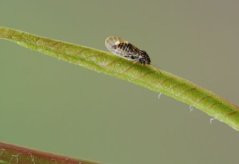
Project
The earwig at the soil stage
Pear psylla is the main plague in Dutch pear farming. The management of natural enemies, including earwigs, plays an important role in the prevention and control of the pear psylla. The presence of earwigs varies greatly between the Dutch pear orchards.
The research in this public-private partnership project will result in new knowledge about the life and food requirements of young earwigs. This knowhow can help prevent damage to trees and fruit as a result of the pear psylla and reduce dependence on chemical crop protection products. In addition, the project contributes to a greater biodiversity in orchards.
Goals

The goal of the project is making the pear psylla a controllable plague by stimulating the presence of earwigs in orchards. To achieve this, the project will collect fundamental knowledge about factors that determine the success of earwigs at the soil stage (November to April). This should have the following results:
In addition to overwintering in the orchards the earwigs also have sufficiently good conditions to reproduce successfully.
We have knowledge of what young earwigs eat in the period that they are in a nest in the soil in the early spring, and where they obtain this food.
Approach
The research consists of four stages:
- Developing a DNA technique to systematically determine the diet through the stomach contents of young earwigs. Studying the foraging behaviour of the mother earwig during the soil stage. Identifying the behaviour of earwigs using night cameras.
- Studying the effect of various diets on the growth and survival of young earwigs by keeping them in controlled conditions in artificial nests. Potentially important food sources (such as soil mites and springtails) will be provided in varying amounts, after which the number of successfully reared young earwigs will be determined.
- Studying the availability of suitable food in Dutch orchards by analysing soil samples for soil organisms that could serve as a food source for young earwigs and measuring earwig density in these locations.
- Studying the factors which determine food availability in the soil: which factors have a positive or negative effect on the prey suitable for earwigs and how can the amount of prey be stimulated.
Results
- There is a validated DNA technique available for determining the stomach content of earwigs. It is clear what young earwigs eat in the soil stage and the effect thereof on their growth and survival.
- It is known which food is available at which times in the Dutch orchards and how this varies between orchards.
- Fruit growers have tools with which they can influence the soil life.